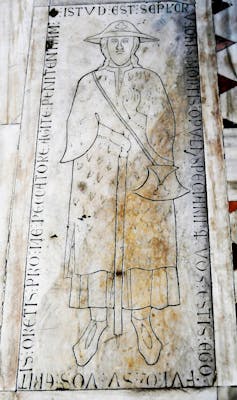
https://www.youtube.com/watch?v=uKiGMGkc0xk screenshot via Wikimedia.com, CC BY
By Virginia Raguin, College of the Holy Cross, The Conversation
Luce, the anime-inspired official mascot for the Catholic Church’s 2025 Jubilee, whose name means “light” in Italian, has been getting a lot of attention on social media. Some people love the cartoon and find her “cute,” but a few others consider her “unsuitable” and even “repugnant.”
The Vatican introduced Luce at a comics convention in Italy, with the goal of engaging young people and speaking about the theme of hope.
Designed by Simone Legno, the mascot with big blue eyes and blue hair, and rosary beads around her neck, represents a Catholic pilgrim. She is dressed in pilgrimage garments that were standard attire throughout the centuries. Her badge, the Pilgrimage of Hope, identifies the 2025 Jubilee. It shows blue, green, yellow and red figures embracing a cross that ends in an anchor at the base, a symbol of hope. The figures form an outline of a ship sailing over the waves, evoking images of travel.
I have long been interested in the central role played by pilgrimage in many faith traditions, culminating in an exhibition and book, “Pilgrimage and Faith: Buddhism, Christianity, and Islam” in 2010. Luce brings a contemporary perspective to the time-honored Christian pilgrimage tradition.
Pilgrimage symbols
The symbols that Luce carries serve as a reminder of the origins of Christian pilgrimage, which began with visits to the Holy Land, the place where Christ lived his life.
This pilgrimage was documented by a person who came to be known as the Anonymous Pilgrim of Bordeaux. He wrote in his diary “The Bordeaux Pilgrim” in 333 about his trip to the Holy Land when the basilica of the Holy Sepulcher, the site where Jesus was buried and is believed to have resurrected, was still under construction.
Luce carries symbols that have been associated with pilgrimage in Europe since the 12th century, particularly those connected to the shrine of St. James in northwestern Spain.
This Holy Land pilgrimage built a tradition of Christians not just visiting the holy sites but also returning with tangible souvenirs, such as a stone from the Holy Land, water from a well, or even a piece of cloth or a statue that touched Christ’s tomb. A sixth-century painted box now in the Vatican contains bits of soil and stones as souvenirs of places in the Holy Land.

Virginia Raguin, CC BY
The pilgrimage to honor St. James, one of Christ’s apostles, whose tomb was believed to have been found in northwestern Spain, became popular in the early 12th century. The pilgrimage route was called the Way of St. James, Camino de Santiago de Compostela. The pilgrimage guided the faithful through several routes across Spain, France and Portugal, culminating in Santiago de Compostela in Galicia, in the north of Spain.
The itinerary of the journey, written in 1137 by an anonymous Frenchman, names natural landmarks, local customs and specific churches built to honor different saints. Along this route flowed artistic, economic and cultural exchanges. As was customary, pilgrims who returned after visiting St. James’ tomb adopted an emblem. Since the shrine was close to the sea, James’ symbol became a scallop shell that pilgrims wore to demonstrate their achievement.
Pilgrims were proud of these voyages that entailed much physical hardship as well as devotion. In the church of Santa Prassede, Rome, Giovanni de Montpoli, who describes his trade as preparing medicines, commissioned a 13th-century tomb slab showing himself as a pilgrim. He is dressed in a pilgrim’s fur overcoat to repel rain and retain warmth. He carries a staff and wears a wallet slung over his shoulder. A scallop shell adorning his broad-brimmed hat indicates that he had traveled to Compostela.
The popularity of the pilgrimage to St. James persisted through the Renaissance, supported by pilgrimage fraternities that helped people find companions for the journey and stay connected with each other after they returned. Sometimes subgroups of the fraternity even sponsored pilgrimage-related art such as a stained-glass window.
Evidence of such activities is seen in the monastery of Wettingen, near Zurich in Switzerland. St. James is depicted as a pilgrim in a stained-glass window dated 1522, donated by a Hans Hünegger and Regina von Sur. He wears a cloak and a hat decorated with pilgrim badges.
Pilgrim badges

Virginia Raguin, CC BY
By the middle decades of the 12th century, metal pilgrim badges were produced at low costs. They were soon available at shrines throughout Europe. Each pilgrimage location had its own distinctive badge.
Santiago’s scallop shell remained a universal pilgrim emblem over the centuries. A 19th-century stained-glass window in the church of Sainte-Clotilde in Paris shows 13th-century French King Louis IX – the only French monarch to be named a saint – with scallop shells on his cloak, even though his pilgrimage was to Jerusalem, not the shrine of Santiago.

Virginia Raguin, CC BY
Sometimes the Supper at Emmaus, when Christ met two disciples after his resurrection, was depicted showing the disciples as contemporary pilgrims.
One of the most memorable examples is Caravaggio’s painting from 1601, in the National Gallery in London, showing an astonished apostle wearing a scallop shell on his vest.
Luce, the pilgrim
Luce continues, as well as transforms, these traditions. In her large eyes gleam two scallop shells that reflect this thousand-year-old symbol. Like Giovanni de Montpoli in Rome, she wears a coat that shields her from the elements and she carries a staff. The yellow of the cloak references the color of the flag of Vatican City.
Like the 16th-century Swiss image of St. James, she wears a pilgrimage badge, this one proclaiming the Pilgrimage of Hope of the 2025 Jubilee. Her muddy boots indicate outdoor hiking, with which any young person can identify. She is depicted as female, representing all people, not just women.
Drawn in a contemporary and globally popular style, she suggests an openness to new encounters across the world.![]()
Virginia Raguin, Distinguished Professor of Humanities Emerita, College of the Holy Cross
This article is republished from The Conversation under a Creative Commons license. Read the original article.





















